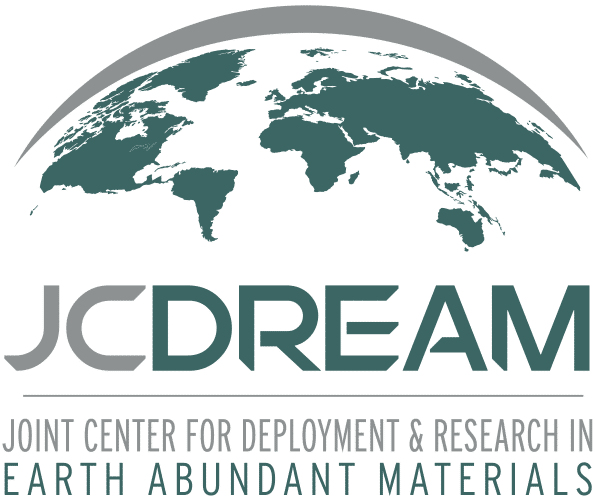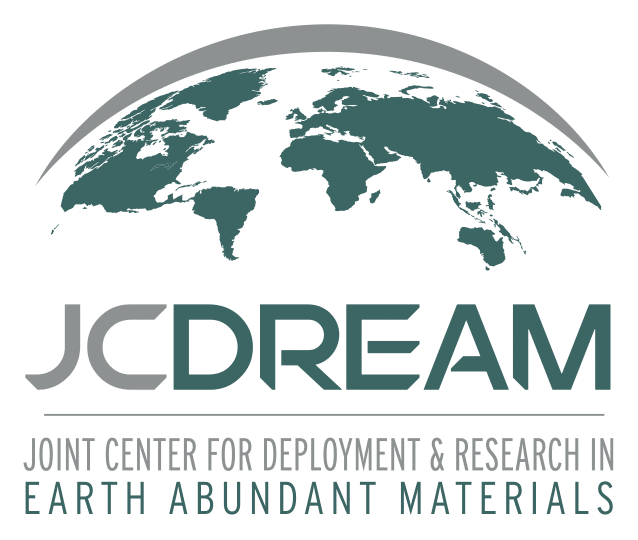We are thrilled to announce the 2020 JCDREAM Seed Grant Awardees. The winners come from a range of institutions throughout the state of Washington. Their projects cover earth-abundant materials science from a variety of angles. We look forward to seeing the results of their research.
1. Materials Washington – Critical, Rare and Abundant Materials Educational Resources
In collaboration with the JCDREAM, MatEdU proposes to continue the establishment and coordination of Materials Washington – an alliance of community and technical colleges working collaboratively with industry, policymakers, and professional associations to advance Washington’s leadership role in the global materials environment. Materials Washington will collaborate across WA’s community and technical colleges to develop learning modules focused on critical, rare, and abundant materials that can be integrated into technician education programs and courses and raise awareness of the materials being used today in everyday life. Materials Washington will work with JCDREAM to promote and implement the JCDREAM Symposium and will host an annual meeting focused on earth-abundant and critical materials education.
We recognize that a large number of clean and renewable energy technologies are dependent on rare earth elements and other expensive, difficult-to-source earth components. These technologies—wind turbines, solar panels, hybrid/electric car batteries— are critical to reducing carbon emissions. The need to share information about materials is key; therefore, the need to educate technicians in the handling of rare and critical materials as well as abundant Earth materials and their alternatives, is crucial.
Principal Investigator: Mel Cossette | National Resource Center for Materials Technology Education, Edmonds Community College
Principal Investigator: Ann Avary | Center of Excellence for Maritime Manufacturing and Technology, Skagit Valley College
Industrial Collaborator: George Parker | Boeing
2. ChocoLED – Naturally Derived Color Converters for Solar Cell Efficiency Enhancement
ChocoLED envisions “Green chemistry for green energy.” They are dedicated to the development of environmentally sustainable technology for solar cell efficiency enhancements. By using bio-renewable compounds as the key ingredient, ChocoLED’s method eliminates several supply chain issues without compromising fluorescent efficiency. The efficiency of existing solar cell technology can then be even further improved by incorporating their material.
Existing color converters are inorganic phosphors relying on rare-earth or toxic elements. The production of most inorganic phosphors is largely dependent on rare-earth elements, making the supply chain subject to political motivations, which is particularly important given that 80-95% of global rare-earth production is still from China. In addition, rare-earth refineries involve a series of acid bath treatments and unhealthy doses of radiation, raising concerns regarding environmental pollution and laborer health. Next-generation materials, such as highly fluorescent quantum dots, consists of toxic heavy metals (Cd, Hg, and Pb), which are already restricted by the Restriction of Hazardous Substances Directive (RoHS) in the European Union. Looking toward the future, successful adoption and integration of ChocoLED materials into solar panels would prevent the introduction of critical materials, as well as toxic materials, into solar panel products.
Principal Investigator: Christine Luscombe, PhD | University of Washington, Department of Materials Science & Engineering
Principal Investigator: Michael Pomfret , PhD | University of Washington, Washington Clean Energy Testbeds
3. Supply Chain Data Science – Critical Materials Decision Support System based on Machine Learning: Battery Materials Case Study
This project brings together a team of three professors (John McCloy, Scott Beckman, and Min-Kyu Song) in the School of Mechanical and Materials Engineering at Washington State University with complementary expertise in materials technology and industrial processes, data science, machine learning, and battery materials. They will collaborate with Microsoft battery researchers to create a data-enabled scaffolding to understand and quantify critical material supply chain risks in battery technologies. To achieve this objective, data will be harvested from a wide range of literature resources from government, private, and scientific communities, and advanced decision-making methods (including data science, machine learning, and decision support systems) will be applied.
The project will foster interactions between WSU and Microsoft on critical materials needs, and grow in-state expertise in critical materials issues at the academic level. The project will expose student researchers to methods in textual analysis methods in data science and will provide an opportunity for educational outreach to PhD students in the materials science and engineering program emphasizing economic and supply chain issues with today’s technologies, thus fostering awareness of these system-level issues as critical factors in the design process for the next generation of consumer devices.
During its collection, the data will be tagged as either open or proprietary. The open data, harvested from public literature, will be shared via a GitLab server managed by the WSU Voiland College of Engineering IT. Any proprietary data will be used in the analysis, which will be made public, but the data itself will remain undisclosed. Through the respectful stewardship and distribution of data, we hope to create a data-sharing project that rises to national importance.
Principal Investigator: John McCloy, PhD | Washington State University, School of Mechanical and Materials Engineering
Principal Investigator: Scott Beckman, PhD | Washington State University, School of Mechanical and Materials Engineering
Principal Investigator: Min-Kyu Song, PhD | Washington State University, School of Mechanical and Materials Engineering
Industrial Collaborator: Microsoft
4. Open Access Performance Evaluation and Improvement of Second-Life Batteries for Stationary Storage Applications
Lithium-ion battery enabled electrification efforts within the United States aim to directly reduce fossil fuel contributions to climate change. However, there remain critical hidden costs that limit the potential benefits: high energy intensity of production, limited battery cycle life, and the associated economic barriers to disposal.
This project aims to improve the overall economics of Li-ion batteries (LiBs) in a circular economy by linking two disparate sectors: re-purposing retired electrified bus batteries (transportation) into grid-integrated energy storage applications (energy distribution). Deploying used bus batteries for second-life use is in its infancy. Significant uncertainty regarding the performance and remaining useful life of second-life batteries still remains.
BattGenie has developed an advanced battery management system (BMS) using physics-based models that have demonstrated significant extension to battery cycle lives compared to standard methods of battery operations and that technology could advance the longevity and manageability of second-life battery applications. During this project, BattGenie, Washington Clean Energy Testbeds, Snohomish PUD, and King CountyMetro will partner to re-purpose and deploy used 100kWh battery modules on pumped hydro stations, with the goal of providing load-leveling and demand reduction services on Snohomish PUD’s distribution grid.
BattGenie’s BMS will extend the remaining battery cycle life while simultaneously providing more accurate performance parameters and projected lifespan estimations. To contribute to the broader base of knowledge in this space, physical system integrity information and battery performance data collected from the baseline installations not using BattGenie’s proprietary technology will be shared in an open-access fashion, via a webpage that will link to both the BattGenie and the WCET websites. This will enable other researchers working on second use batteries to characterize and benchmark the performance of the used batteries for their respective planned usage. The database will be continuously updated as more data is collected from the Installations.
Principal Investigator: Manan Pathak, PhD | BattGenie Inc.
Industrial Collaborator: Robert Marks | Snohomish County PUD
Industrial Collaborator: Tallon Swanson | King County Metro Transit
Industrial Collaborator: Evan Ramsey | Bonneville Environmental Foundation
Collaborator: Michael Pomfret, PhD | Washington Clean Energy Testbeds
5. Cellulose-based Nanocomposite Structures to Mine Lithium from Seawater
The growing use of Li-ion batteries has made lithium a critical resource, motivating researchers to explore its extraction from seawater. However, previously explored approaches remain resource-intensive and unsustainable for practical use. Given the low concentrations of lithium in seawater, to be economically viable, lithium extraction approaches must be both highly selective and inexpensive. Under this seed grant, the project team will develop inexpensive and environmentally sustainable nanocomposite structures with the necessary Li-ion selectivity.
Cellulose, the world’s most abundant polymer, can be easily sourced from agricultural waste biomass and can be scalably processed to prepare high-surface-area porous structures. This team will investigate three different configurations of cellulose-based scaffolds, namely molded hydrogel, 3D-printed hydrogel, and carbonized hydrogel. By introduction into the cellulose scaffold nanoparticles of metatitanic acid (H2TiO3), which is shown to selectively capture Li+ in the presence of other competing cations (Na+, K+, Ca2+), even at low Li+concentrations, we can develop an inexpensive, yet effective Li-ion extraction nanocomposite structure. The structure, morphology, mechanical properties, and Li+ capturing efficiency of the nanocomposite structures will be characterized and iteratively improved.
Once the nanocomposite structures are saturated with Li+, they can be regenerated and reused with a simple acid wash. The near-term goal is to develop the inexpensive nanocomposite and demonstrate its ability to reversibly capture Li+, and to perform thorough materials characterization and iterative optimization to achieve improved Li+ capture capacities with the new nanocomposite. The long-term goal is to couple the use of this material with electrochemical processes that generate regenerants on-site using seawater and renewable energy, to eliminate the need for regular chemical inputs for sustainable lithium mining from seawater. The outcomes of this work are of clear interest to the broader scientific community, and the project will offer research opportunities to several undergraduate and masters students contributing to their education.
Principal Investigator: Eleftheria Roumeli, PhD |University of Washington, School of Materials Science and Engineering
Principal Investigator: Chinmayee Subban, PhD | Pacific Northwest National Laboratory, Energy and Environment Directorate
6. Durable and Selective Catalysts Based on Earth-Abundant Materials for Biomass Conversion
Supported metal catalysts play critical roles in the catalytic hydrodeoxygenation of biomass to produce fuels and chemicals. While noble platinum group metals (PGM) have been widely explored, much less expensive earth-abundant materials such as iron (Fe) are highly desired. Wang et. al. have recently discovered the promising activity of Fe-based catalysts in the selective hydrodeoxygenation of lignin-derived phenolics. However, rapid catalyst deactivation due to the oxidation of Fe and non-selective C-O/C-Chydrogenolysis in the liquid phase of hydrodeoxygenation are identified as two major issues. To address these issues, we have assembled a team with essential skills. Andrew Ingram from ADM will provide guidance and advice in ensuring the commercial viability of the catalyst systems developed, Mark Engelhard and Libor Kovarik from PNNL will conduct advanced catalyst characterization, and Jean-Sabin McEwen at WSU will provide theoretical calculations for the catalysts.

